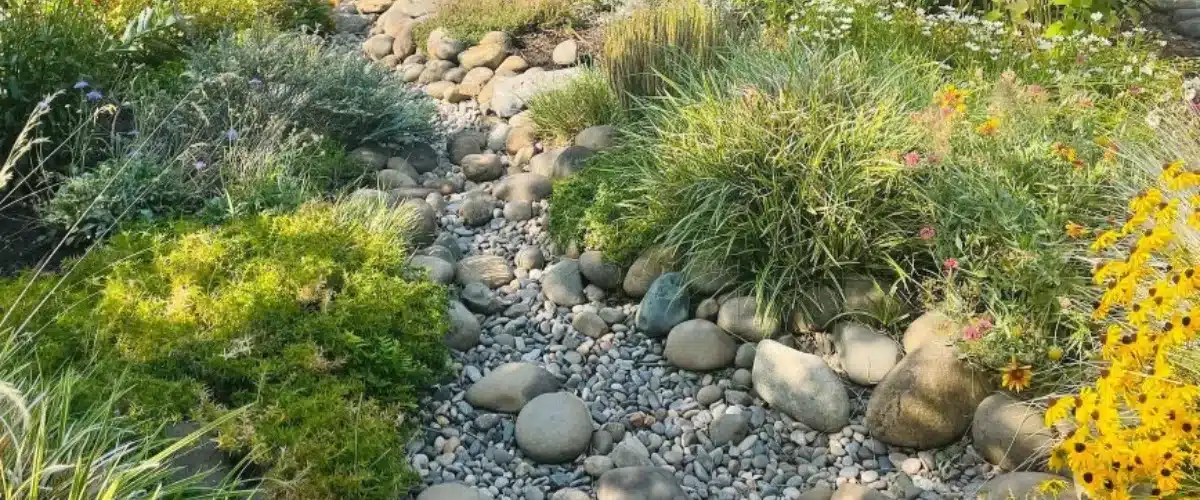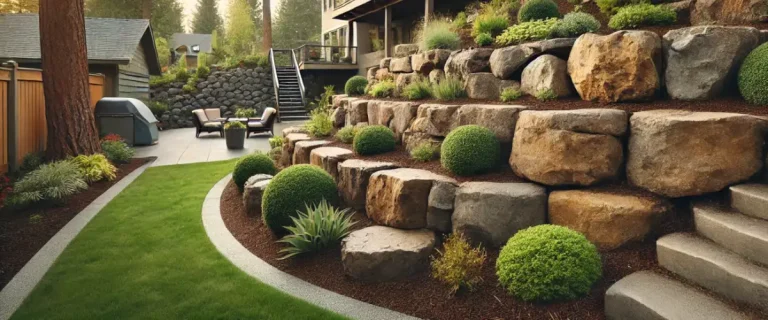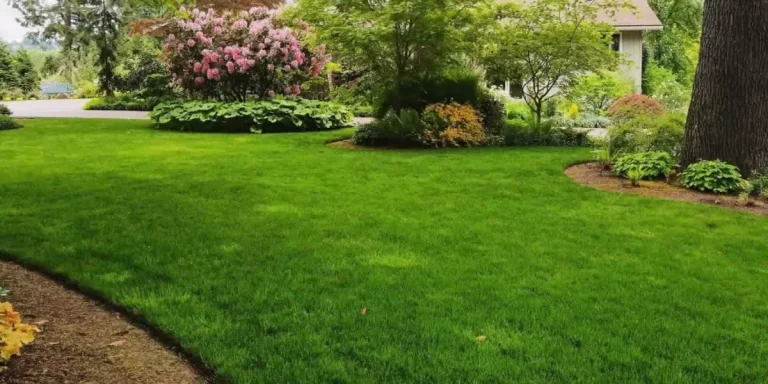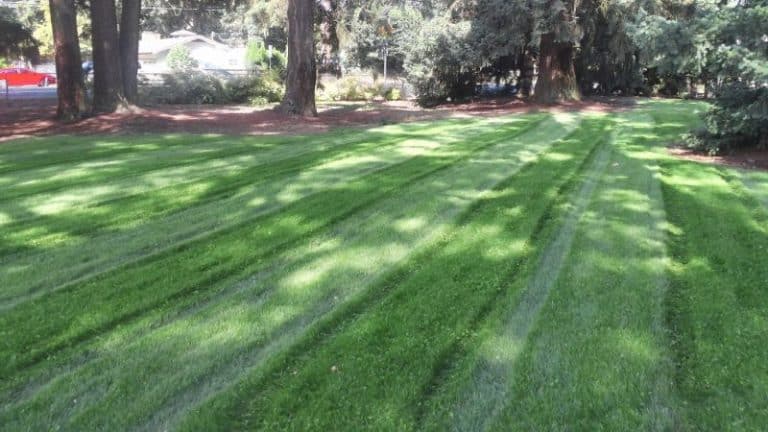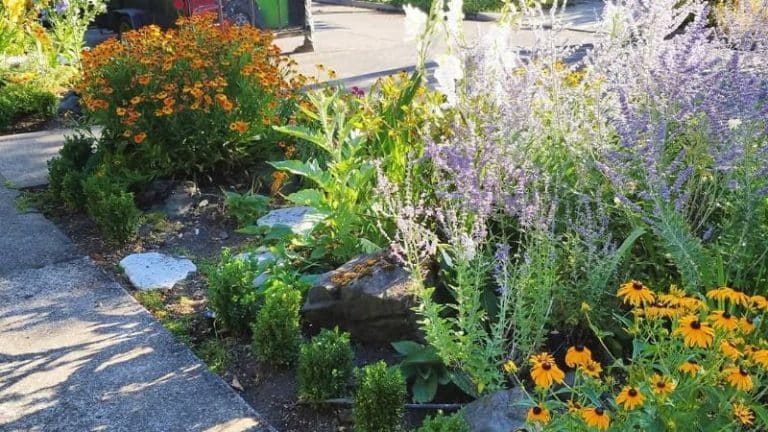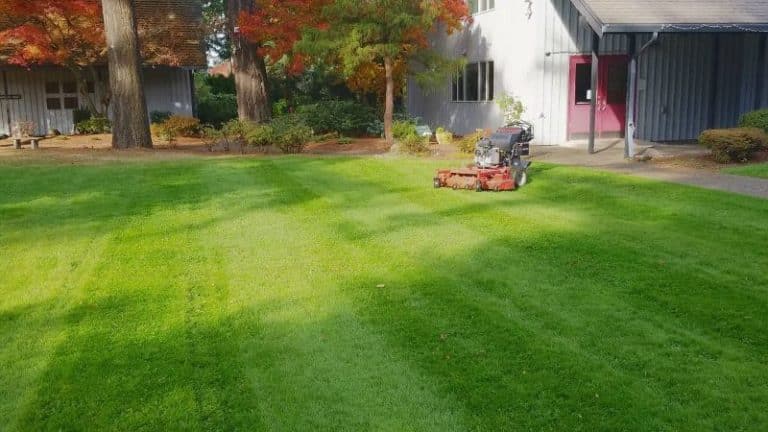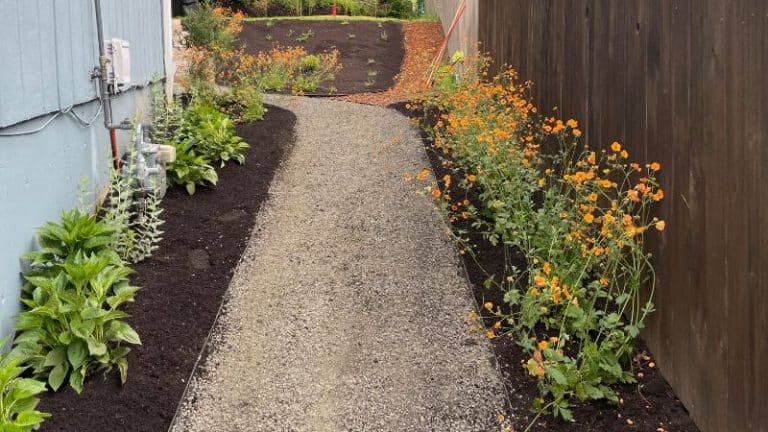What Is A Rain Garden And How Does It Work?
If you’re dealing with drainage issues such as standing water, soggy lawns, or soil erosion, a rain garden could be the solution you need. Rain gardens are not only functional but also beautiful, blending seamlessly into landscapes while managing water runoff effectively. They are especially beneficial in regions like Clackamas County, Oregon, where heavy rains and clay-heavy soils can lead to significant drainage challenges. In this article, we’ll explore what a rain garden is, how it works, and how you can use native and non-native plants to create one that thrives in the Pacific Northwest.
A rain garden is a shallow, planted depression that collects and absorbs rainwater runoff from impervious surfaces such as roofs, driveways, and patios. It acts as a natural filtration system, capturing water and allowing it to slowly infiltrate the ground instead of flowing into storm drains. By doing so, rain gardens help reduce runoff, improve water quality, and prevent erosion.
Unlike a typical garden bed, a rain garden is strategically designed to handle varying water levels. It features a mix of plants, including those that tolerate both wet and dry conditions, and uses soil that promotes absorption. Rain gardens also provide an opportunity to create a visually appealing landscape feature that benefits both the homeowner and the environment.
How Does a Rain Garden Work?
Rain gardens are carefully engineered to mimic natural water management systems. Here’s how they function:
Collecting Water: Rainwater is directed into the garden through downspouts, swales, or shallow trenches. These features guide runoff from hard surfaces like roofs, driveways, and patios into the garden. Proper grading ensures the water flows smoothly into the designated area without pooling in unintended spots.
Slowing Water Flow: The shallow depression of a rain garden is designed to temporarily hold water, allowing it to spread out and slow down. This prevents the rapid runoff that can lead to soil erosion and flooding in nearby areas. The gradual water infiltration mimics the natural hydrological cycle.
Filtering Pollutants: As the rainwater percolates through the garden’s layers of soil, sand, and organic material, pollutants like oil, grease, pesticides, and fertilizers are captured and broken down by microbes in the soil. Plant roots play a vital role in absorbing excess nutrients such as nitrogen and phosphorus, further improving water quality.
Recharging Groundwater: Rain gardens allow water to seep deeply into the soil, replenishing aquifers and the local water table. This is especially beneficial in regions like Clackamas County, where clay-heavy soils can hinder natural drainage. The garden ensures that excess rainwater is absorbed gradually rather than contributing to surface runoff.
Supporting Local Ecosystems: By creating a rain garden, you also establish a micro-ecosystem that benefits the environment. Native plants in the garden provide habitat and food for pollinators such as bees, butterflies, and birds, enhancing biodiversity.
Minimizing Impact on Stormwater Systems: Rain gardens reduce the volume of water entering storm drains, lessening the burden on municipal systems and decreasing the likelihood of urban flooding during heavy rains.
By understanding these processes, homeowners can see how rain gardens go beyond being just a functional addition to a yard. They are a sustainable solution that harmonizes aesthetics, practicality, and environmental responsibility.
Benefits of Installing a Rain Garden
Rain gardens offer numerous advantages that go beyond solving drainage problems. Here are some of the key benefits:
Prevents Standing Water: By directing and absorbing runoff, rain gardens effectively reduce water pooling in your yard. This not only protects delicate plants and landscaping features from drowning but also minimizes the conditions that attract pests like mosquitoes. Standing water can become a breeding ground for these insects, leading to potential health and comfort concerns. A well-designed rain garden ensures that water is quickly absorbed, keeping your yard dry and usable.
Erosion Control: On sloped properties, rain gardens play a vital role in stabilizing soil. Heavy rains can cause significant erosion, washing away topsoil that is crucial for healthy plant growth. By slowing the flow of water and encouraging absorption, rain gardens prevent this loss and maintain the integrity of your landscape. Over time, this can save homeowners money on soil replenishment and landscaping repairs.
Improves Water Quality: Rain gardens act as natural filtration systems, removing harmful pollutants from runoff before it enters local waterways. Oil, grease, pesticides, and fertilizers are common contaminants found in urban runoff. The plants and soil in a rain garden work together to break down these pollutants, ensuring that only cleaner water returns to the groundwater system. This contributes to healthier streams, rivers, and ecosystems in your community.
Provides Wildlife Habitat: Many of the plants used in rain gardens attract beneficial wildlife such as bees, butterflies, and birds. These species play an essential role in pollination and maintaining local biodiversity. For example, native plants like Douglas Spirea and Western Columbine provide both food and shelter for pollinators. By installing a rain garden, you create a thriving microhabitat that supports the environment while adding life and movement to your yard.
Adds Aesthetic Value: Beyond their functionality, rain gardens are an attractive addition to any property. With carefully chosen plants and thoughtful design, they can become a focal point in your landscape. Vibrant flowers, lush greenery, and the dynamic interplay of textures and heights create visual interest. Incorporating features like decorative stones, paver borders, or artistic stepping stones can further enhance their appeal, making your rain garden a conversation starter while increasing your property’s curb appeal.
Supports Sustainable Living: Rain gardens are a practical step toward sustainable landscaping. By reducing your reliance on stormwater systems and managing runoff onsite, you’re contributing to a more environmentally friendly way of living. This proactive approach aligns with Oregon’s commitment to sustainability and can inspire others in your community to adopt similar practices.
Best Locations for a Rain Garden
A rain garden can be installed in a variety of locations on your property, but careful planning ensures its effectiveness and long-term success. Here are some considerations for finding the best location:
Low-Lying Areas: Identify spots where water naturally collects or flows during heavy rain. Areas at the base of slopes, depressions, or natural drainage paths are ideal since they already channel water. Installing a rain garden here takes advantage of the existing flow, providing a functional and efficient solution.
Near Runoff Sources: Position the rain garden near areas that generate significant runoff, such as downspouts, driveways, patios, or walkways. Capturing water close to its source prevents it from spreading across your yard and overwhelming less-permeable areas. Use swales or trench extensions to direct water efficiently into the rain garden.
Away from Foundations: Maintain a safe distance of at least 10 feet between the rain garden and your home’s foundation. This precaution prevents water from seeping into basements or crawl spaces and avoids potential structural damage. Similarly, avoid placing the rain garden near septic systems or underground utilities.
Sunny or Partially Shaded Areas: Most rain garden plants thrive with ample sunlight. Choose a location that receives at least 6 hours of direct sunlight per day. If full sun isn’t available, select plants adapted to partial shade, ensuring they flourish in the chosen spot. Balancing light exposure with plant needs is key to a thriving garden.
Good Soil Drainage: Conduct a soil percolation test to verify that the chosen location can absorb water effectively. If the soil drains too slowly (e.g., heavy clay), consider amending it with sand and compost to improve permeability. This adjustment ensures the rain garden can handle the expected runoff volume.
Visible and Accessible Area: Choose a location that integrates well with your existing landscape and is easy to monitor and maintain. Placing the rain garden in a prominent area, such as a front yard or along a walkway, highlights its aesthetic value while demonstrating your commitment to sustainable landscaping.
Away from High Traffic Zones: Avoid placing the rain garden in areas with heavy foot traffic or frequent vehicle use. This reduces the risk of soil compaction, which can impede drainage and damage plants. Instead, choose a location that allows the garden to function undisturbed.
By carefully selecting the location, you can maximize the efficiency and impact of your rain garden, ensuring it complements your property while solving drainage challenges.
Appropriate Plants for Rain Gardens in Clackamas County
Plant selection is one of the most important aspects of designing a rain garden. In the Pacific Northwest, including Clackamas County, it’s ideal to use a mix of native and non-native plants that are well-suited to the region’s wet winters and dry summers.
Native Plants:
Douglas Spirea (Spiraea douglasii): Known for its pink summer blooms, this hardy shrub thrives in wet soils and provides excellent erosion control.
Oregon Iris (Iris tenax): A striking perennial that handles moist conditions well, adding vibrant purple hues to your garden.
Redtwig Dogwood (Cornus sericea): This shrub’s red stems provide year-round visual interest and perform well in rain garden environments.
Western Columbine (Aquilegia formosa): Perfect for attracting pollinators, this plant adapts to both wet and dry conditions, making it a versatile choice.
Slough Sedge (Carex obnupta): This grass-like plant thrives in wet conditions and is excellent for stabilizing soil and preventing erosion in rain gardens.
Tufted Hairgrass (Deschampsia cespitosa): A native ornamental grass that adds texture and movement, it tolerates both wet and dry conditions well.
Non-Native Plants:
Daylilies (Hemerocallis spp.): These hardy perennials tolerate a range of moisture levels and bring bold colors to the garden.
Swamp Milkweed (Asclepias incarnata): Ideal for wetter areas of the rain garden, this plant supports monarch butterflies.
Japanese Forest Grass (Hakonechloa macra): A great option for shaded rain gardens, offering unique texture and movement.
Creeping Jenny (Lysimachia nummularia): A vibrant groundcover that thrives in moist areas, providing a lush carpet of green or yellow foliage.
Blue Flag Iris (Iris versicolor): A stunning addition to wetter areas of a rain garden, it features striking blue-purple blooms and thrives in standing water.
Hostas (Hosta spp.): Excellent for shaded rain garden areas, these plants bring large, decorative foliage and thrive in moisture-rich environments.
Astilbe (Astilbe spp.): Known for its plume-like flowers, this plant thrives in part-shade and wet soil, adding height and color to rain gardens.
By incorporating a diverse selection of native and non-native plants, you can create a rain garden that is not only functional but also visually captivating throughout the year. The mix of textures, colors, and heights will enhance your landscape while effectively managing water.
Designing and Building a Rain Garden
Creating a rain garden requires careful planning and execution. Here are the key steps, elaborated to ensure a successful project:
Assess Your Property:
-
-
- Identify Low-Lying Areas: Begin by observing your property during heavy rains to locate areas where water naturally pools or flows. These areas are ideal for rain garden placement as they are already predisposed to collect runoff.
- Conduct a Soil Percolation Test: Dig a small hole about 12 inches deep and fill it with water. Measure how long it takes for the water to drain. If it drains within 24 hours, the soil is suitable for a rain garden. If drainage is slow, amend the soil with sand and compost to improve permeability.
-
Plan the Layout:
-
-
- Determine the Size: Calculate the size of your rain garden based on the amount of runoff it will receive. A general rule is to make the rain garden 10-20% of the area draining into it. For example, a 500-square-foot roof section may require a 50-square-foot rain garden.
- Divide into Zones: Organize the rain garden into three zones based on water tolerance. The center will be the wettest and is ideal for water-loving plants, while the edges should be reserved for drought-tolerant species.
- Consider Accessibility: Incorporate paths or stepping stones for easy maintenance without compacting the soil.
-
Excavate and Prepare the Site:
-
-
- Shape the Garden: Excavate the area to create a shallow basin with gentle slopes leading into the center. The depth should generally range from 6 to 12 inches, depending on the volume of runoff.
- Amend the Soil: Replace compacted or clay-heavy soil with a well-draining mix of 50% sand, 30% compost, and 20% topsoil. This ensures proper infiltration and supports plant growth.
- Create an Inlet and Outlet: Design an inlet to guide runoff into the garden, such as a swale or pipe from a downspout. Include an outlet to handle overflow during heavy rains, directing excess water to a safe location.
-
Plant and Mulch:
-
-
- Select Appropriate Plants: Choose a mix of native and non-native plants suited to the region and the zones within your garden. Arrange them according to their water and sunlight needs.
- Add Mulch: Apply 2-3 inches of mulch to the surface to retain moisture, suppress weeds, and prevent soil erosion. Use heavier mulch like shredded bark to avoid it washing away.
-
Add Finishing Touches:
-
-
- Enhance Aesthetics: Incorporate decorative stones, edging, or paver borders to give the rain garden a polished look.
- Install Stepping Stones: Place stepping stones strategically to allow easy access for maintenance while preserving the garden’s integrity.
- Ensure Proper Drainage: Test the rain garden during a rainstorm to confirm that water flows into the basin, drains properly, and doesn’t cause erosion around the edges.
-
By following these detailed steps, you can create a rain garden that effectively manages runoff while enhancing the beauty and sustainability of your property.
Maintaining a Rain Garden
Once installed, a rain garden requires regular maintenance to remain effective and visually appealing. Proper care ensures the garden continues to manage runoff efficiently while supporting plant health and biodiversity. Here’s how to maintain your rain garden:
Weed Control
-
-
- Regularly inspect the garden for invasive plants that can overtake desirable species.
- Hand-pull weeds to avoid disturbing the soil and established plants.
- Use mulch to suppress weed growth and retain moisture, refreshing the layer as needed.
-
Inspect Drainage
-
-
- After heavy rainfall, check for water pooling in the garden or overflowing at the edges.
- Ensure that inlets and outlets are clear of debris to maintain proper water flow.
- Address erosion issues immediately by adding soil or adjusting slopes to stabilize affected areas.
-
Replenish Mulch
-
-
- Annually add 2–3 inches of hardwood mulch to retain moisture, reduce weed growth, and prevent erosion.
- Choose heavier mulch materials, like shredded bark, to minimize displacement during heavy rains.
-
Replace and Prune Plants
-
-
- Remove plants that fail to thrive and replace them with suitable alternatives based on their moisture tolerance.
- Divide and replant overcrowded perennials to encourage growth and maintain balance.
- Trim back plants seasonally to promote healthy growth and prevent them from overtaking the garden.
-
Monitor Soil Health
-
-
- Periodically check for soil compaction, especially in high-traffic areas. Aerate compacted spots if needed.
- Test soil nutrients and adjust with organic compost to support healthy plant growth.
-
Address Pests and Diseases
-
-
- Keep an eye out for signs of plant stress, such as discoloration or holes in leaves.
- Use eco-friendly pest control methods to address infestations without harming pollinators or wildlife.
-
Maintain Aesthetic Appeal
-
-
- Periodically clean decorative stones, edging, and stepping paths to keep the garden looking its best.
- Consider planting seasonal flowers or adding small garden ornaments to enhance visual interest.
-
By following these steps, your rain garden will remain an effective, sustainable, and attractive feature of your landscape for years to come.
Bring Your Landscape to Life with a Rain Garden
A rain garden is more than just a functional solution to drainage issues—it's an opportunity to transform your outdoor space into a vibrant, eco-friendly haven. By managing runoff, supporting biodiversity, and enhancing aesthetic appeal, a rain garden contributes to a sustainable and beautiful landscape that benefits your property and the environment.
Are you ready to make your yard both practical and picturesque? Contact White Oak Landscapes today to explore how a custom rain garden can elevate your landscape while addressing your drainage needs. Let’s work together to bring your vision to life!

